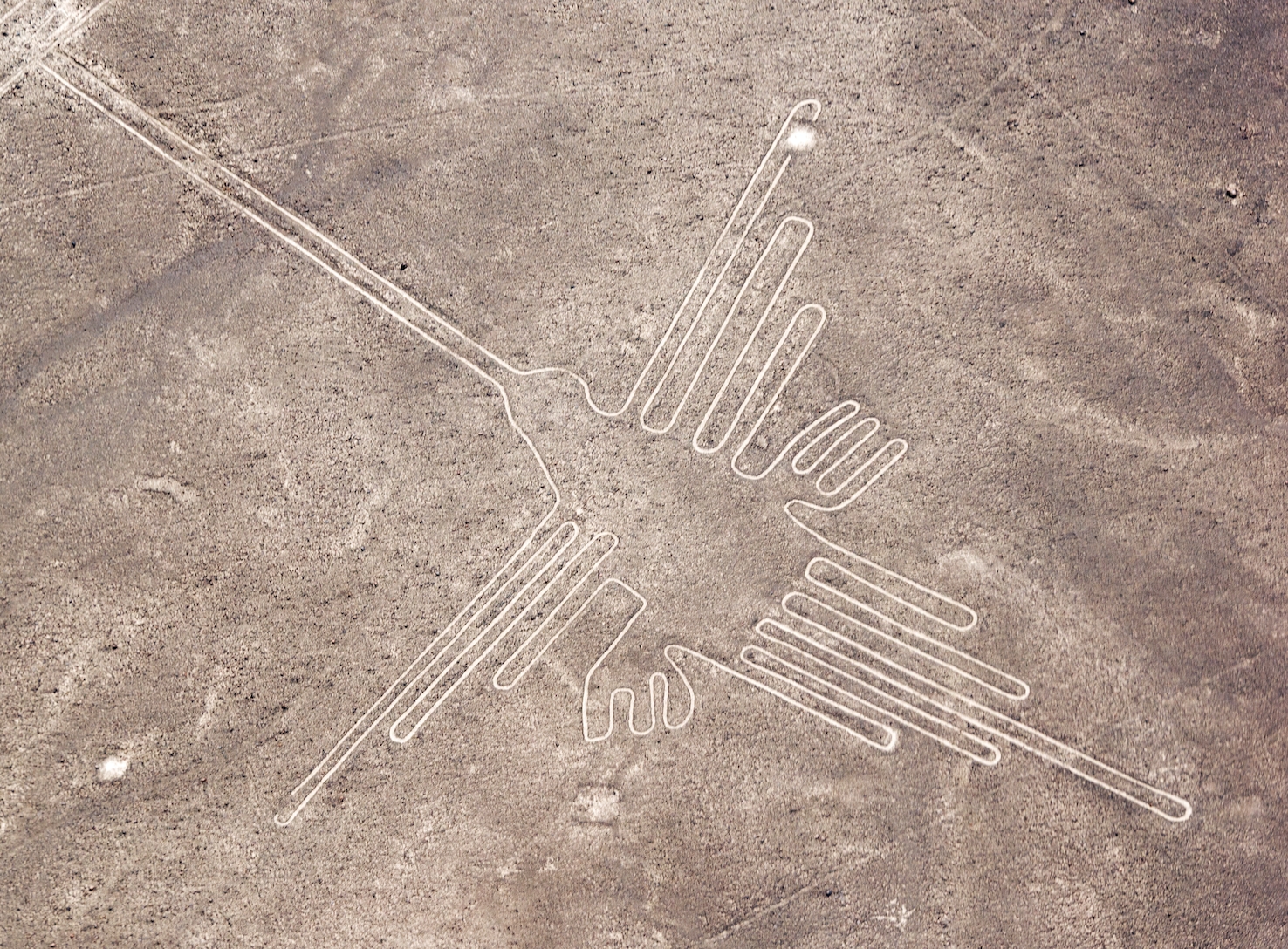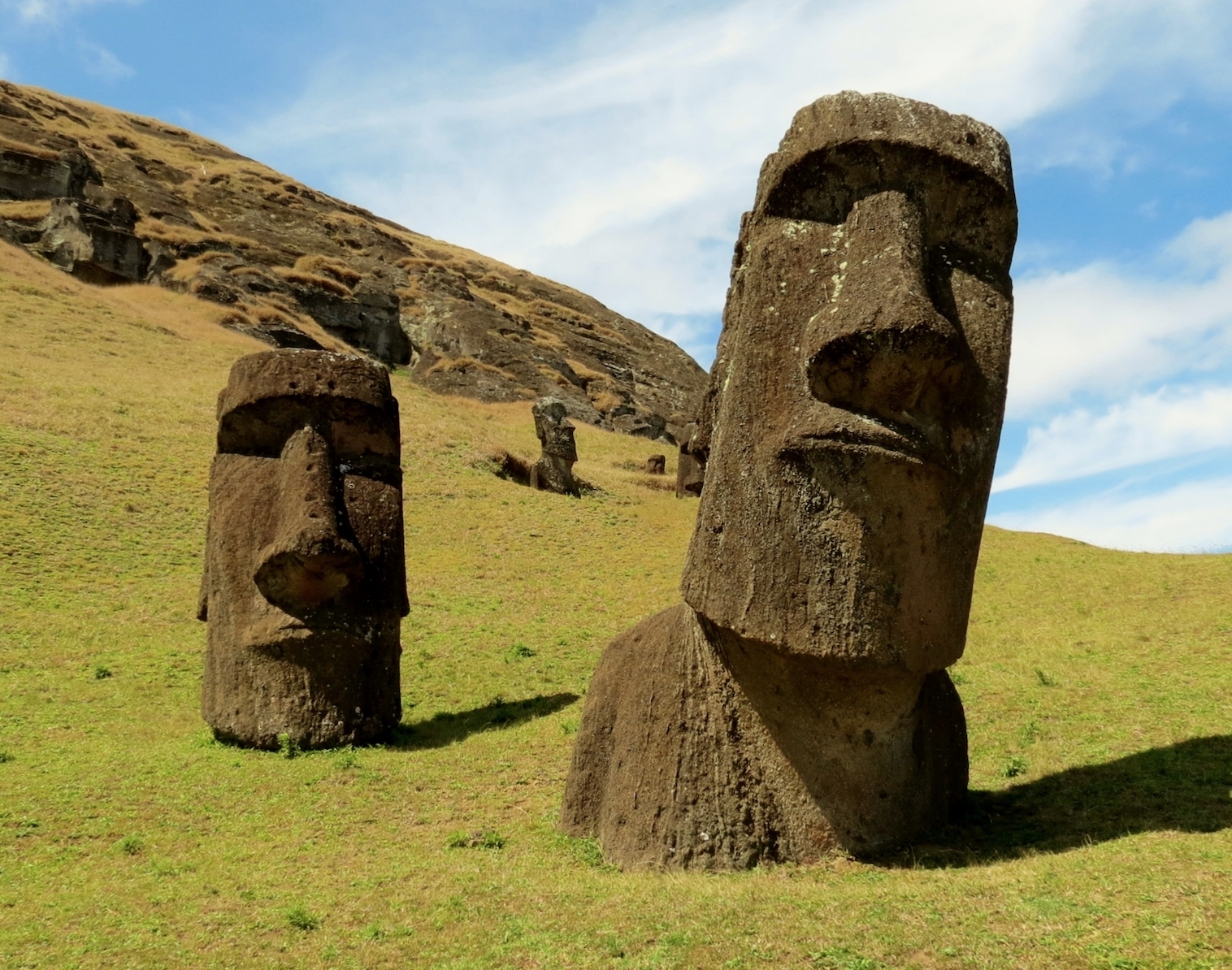A giant, geometric hummingbird in the Peruvian desert. The eerie, white paintings of bulb-headed men in Australian caves. A forest of stone faces ignored by worshipers, in favor of a birdman god. For centuries, geoglyphs, petroglyphs, and ancient structures have exemplified the mystery imprinted on our very landscape. The Nazca lines, Wandjina petroglyphs, and Easter Island statues have all, at some point, been attributed to extraterrestrial architects. Though each has a plausible human origin story, our ongoing fascination points to greater questions about the universe: Are we alone? Have we always been alone? What lies beyond the reach of our furthest sight and measurement?
In 2015, the market research firm YouGov reported that 56 percent of Germans, 54 percent of Americans, and 52 percent of British believe that intelligent alien life exists. But according to astronomer Jean Schneider, though non-Western societies refer poetically to other worlds in works like the Indian Mahabharata and the Chinese Gujin ushu Jicheng, the rational question of intelligent life has been raised almost exclusively by Westerners.
Josh Gates, host of Expedition Unknown: Hunt for Extraterrestrials (Wednesdays at 9/8c on Travel Channel) agrees. “There’s a real difference in how engaged different cultures are with the subject.”
Gates’s show tries to answer the unanswerable question: Are we alone? To track down some answers, he’s traveled all over the world investigating alien sightings. He’s found that while Americans are 300 times more likely to report a UFO than the global average, other countries aren’t so enthusiastic. In places like Madagascar and Turkmenistan, “There are basically zero annual reports of UFOs.”
So what do non-Western societies believe about extraterrestrial life, particularly those local to these mysterious geoglyphs and structures? We investigated local perceptions around three sites to find out:
The Nazca Lines, Peru

The mystery: Why would the Nazca construct hundreds of large-scale geographic designs when they had no methods of flight or notion of aerial views?
The local take: Scientist believe that around 2,000 years ago the Nazca people constructed more than 800 lines by removing the top inches of red desert soil to reveal light-colored sand underneath. The nearly 400 figures (including 70 animal and plant designs) were first discovered in 1926, by Peruvian archaeologist Toribio Mejía Xesspe. Xesspe never attributed the lines to extraterrestrial origins. Instead, he speculated that they were ceremonial paths. In his 1978 book Pathways to the Gods: The Mystery of the Nazca Lines, British documentarian Tony Morrison reported that local tribes still used stations along the lines as huacas, or traditional Inca holy places.
The sheer size of the figures and their commanding impression from above have invited speculation that Nazca were attempting to communicate with a celestial presence. However scientists currently believe that the Nazca lines were created for prayer rituals, as many of the animals depicted are believed to possess water- and fertility-related significance. Recent research suggests the shapes can be made from primitive measuring tools and seen from nearby higher elevations, so it’s unlikely that the Nazca received extraterrestrial assistance.
The Wandjina Petroglyphs, Northwestern Australia
The mystery: Why would the Aboriginal Australians portray water and cloud spirits as helmeted, globe-eyed white men?
The local take: In the Kimberley region of Western Australia, along with the more traditional-looking elongated Gwion stick figures, we find the bulbous heads of the Wandjina petroglyphs. Each figure is humanoid but starkly white-skinned, with cavernous black eyes and what at first appear to be mouths reminiscent of Munch’s The Scream. Some people have theorized that the paintings represented long-ago extraterrestrial visitors to Aboriginal Australia, but their odd ‘helmets’ are probably halo-like headdresses, and their odd low facial cavities are less depiction of existential angst than, well, stylized, well-defined noses.
To this day, the Worawa, Ngarinyin, and Wunumbul peoples of the Kimberley region honor the sacredness of the Wandjina. They say that the 4,000-year-old paintings are self-representations of a supreme rain-maker creator spirit. Only a few artists (including Donny Woolagoodja, who depicted the Wandjina for the Sydney Olympics) are permitted to paint the likeness. These artists also refresh the paint on the existing geoglyphs in what is widely regarded to be the oldest continuous sacred painting movement on the planet.
Explanations vary as to why Aboriginal Australians would choose to use white paint and exaggerated features. Some suggest that the eyes represent thunderstorms, while the many dots on the body symbolize rainfall. Legend says that the Wandjina painted itself as mouthless to curb its own power. The white paint may have been made from convenient materials or chosen for its visibility.
In any case, we’re the society that invented Beavis and Butthead. Do we really get to judge other cultures’ artistic choices?
The Moai Monoliths and Make-Make Petroglyphs, Easter Island, Chile

The mystery: How did a population of 3,000 or less construct some 900 statues? And why did they abandon them to worship a birdman deity?
The local take: In 1722, when Europeans first landed on Easter Island (called Rapa Nui by its inhabitants), they found a population of between 1,500 and 3,000 inhabitants and approximately 900 giant stone statues. The statues, called Moai, were carved from compressed volcanic ash and stood as high as thirty feet, weighing 90 tons. The locals did not care to explain their significance or method of creation.
“The present natives take little interest in the remains,” wrote Katherine Scoresby-Routledge in 1919. “The statues are to them facts of every-day life in much the same way as stones or banana trees.”
She found any explanation offered of their origins to be “wildly mythical.” Instead, she wrote, the locals were heavily invested in Tangata-Manu, or the Birdman Cult, a spiritual group that competed in a yearly Hunger Games-style race to retrieve an egg from an island in shark-infested waters.
The supreme deity of the Birdman Cult was the fertility god Make-Make, and there are some people, according to Josh Gates, who think he was a visitor from another world. When Josh traveled to Easter Island for Expedition Unknown: Hunt for Extraterrestrials, he visited the petroglyph carvings of Make-Make. The god is often depicted with globe-like protruding eyes, a narrow, pronounced nose, and little-to-no mouth. In other words, he looks, as Josh puts it, “a hell of a lot like ET.”
Interestingly, several of those Make-Make petroglyphs also resemble the Wandjina, though with a more sculpted brow.
As for the manpower to build the Moai, a new study suggests that the peak population of Easter Island may have been as many as 17,500 inhabitants, plenty of people to help construct the near-900 head statues. Which is good because, as it turns out, they also have bodies. Talk about a lot of work.
Josh acknowledges that there’s very little concrete data to interpret when it comes to extraterrestrials and what they might want from us. “It all depends on how optimistic you are about the universe,” he says. And who knows? As Vyasa writes in the Mahabharata, “This space which the very gods cannot measure is full of many blazing and self-luminous worlds.” Or, as Josh would have it, “We see a lot of strange lights in the sky.”
Expedition Unknown: Hunt for Extraterrestrials premieres Wednesday at 9/8c on Travel Channel. See below for a sneak peek of the show!






